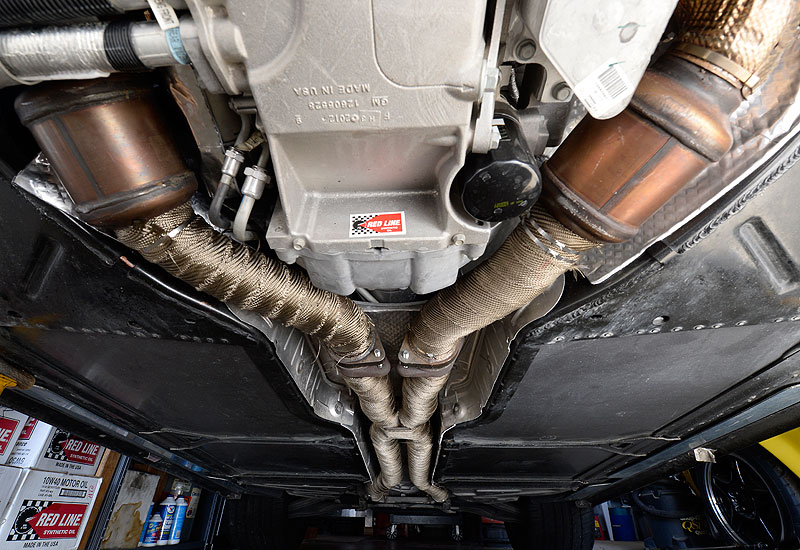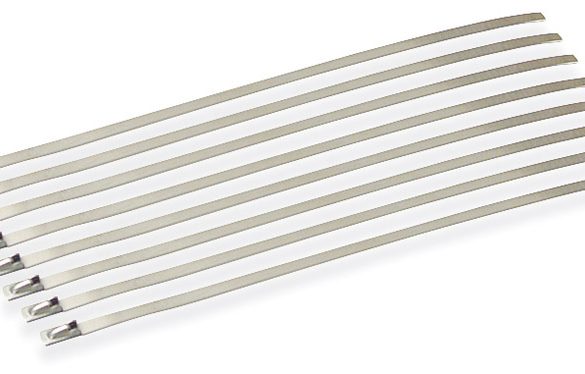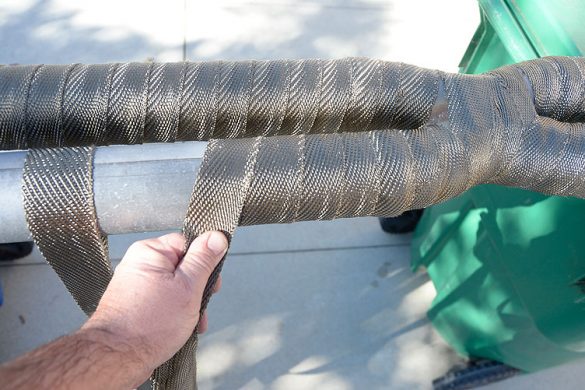Exhaust wrap or “header wrap” has been around since the 1980s. The product is intended to be wrapped around exhaust pipes, then secured with a stainless steel “tie wrap” device. The goal is decreased heat radiation and increased engine performance.
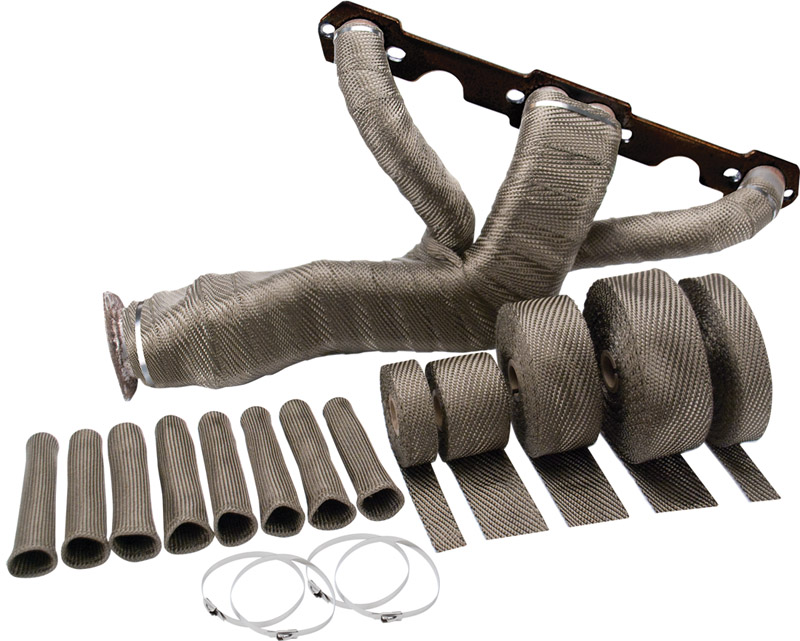 With a road car, the most desirable property of exhaust wrap is that it decreases heat radiation from exhaust system parts. Wrapping exhaust headers and exhaust pipes lowers underhood and undercar temperatures. Some manufacturers of exhaust wrap claim a 50% reduction in underhood temperature, but I think that’s under “ideal conditions”. In real world applications, the temperature reduction is not going to consistently be 50% but, it will, nevertheless, be significant. I have exhaust wrap on the undercar parts of the exhaust systems on two Corvettes and installed on a third for this review. in all three cases, wrapping the exhaust systems decreased the amount of heat radiated from the exhaust through the floor and into the interior. With one of these cars, my ‘71 Big-Block hot rod which is not air conditioned, on a hot day, having the exhaust wrapped makes the difference between an uncomfortable interior and a tolerable interior.
With a road car, the most desirable property of exhaust wrap is that it decreases heat radiation from exhaust system parts. Wrapping exhaust headers and exhaust pipes lowers underhood and undercar temperatures. Some manufacturers of exhaust wrap claim a 50% reduction in underhood temperature, but I think that’s under “ideal conditions”. In real world applications, the temperature reduction is not going to consistently be 50% but, it will, nevertheless, be significant. I have exhaust wrap on the undercar parts of the exhaust systems on two Corvettes and installed on a third for this review. in all three cases, wrapping the exhaust systems decreased the amount of heat radiated from the exhaust through the floor and into the interior. With one of these cars, my ‘71 Big-Block hot rod which is not air conditioned, on a hot day, having the exhaust wrapped makes the difference between an uncomfortable interior and a tolerable interior.
The other advantage of exhaust wrap, cited by most manufacturers of the product, is increased engine performance. They claim that by wrapping the exhaust, more heat is retained in the exhaust flow such that the exhaust gases remain less dense. Exhaust flow is said to be higher because of that. Exhaust wrap makers claim the increased exhaust flow increases torque output. Under certain conditions I suspect that is true, but perhaps not under all conditions. It’s safe to say that engines having some degree of overlap in their camshaft profiles may experience a higher level of exhaust scavenging when exhaust flow is higher due to the pipes being wrapped. That would tend to increase performance on an open exhaust racing engine, provided the engine’s induction system tuning has been optimized for the better flow. While exhaust wrap vendors all claim this potential for increased performance, in the real world, you’d have to do some accurate testing with a dynamometer to corroborate those claims. That kind of testing was outside the budget of this review. When I install exhaust wrap, I’m mainly interested in the comfort benefit, i.e.: decreasing heat radiating into the interior. If there’s also a performance benefit in a street high-performance application, I’ll take that, too.
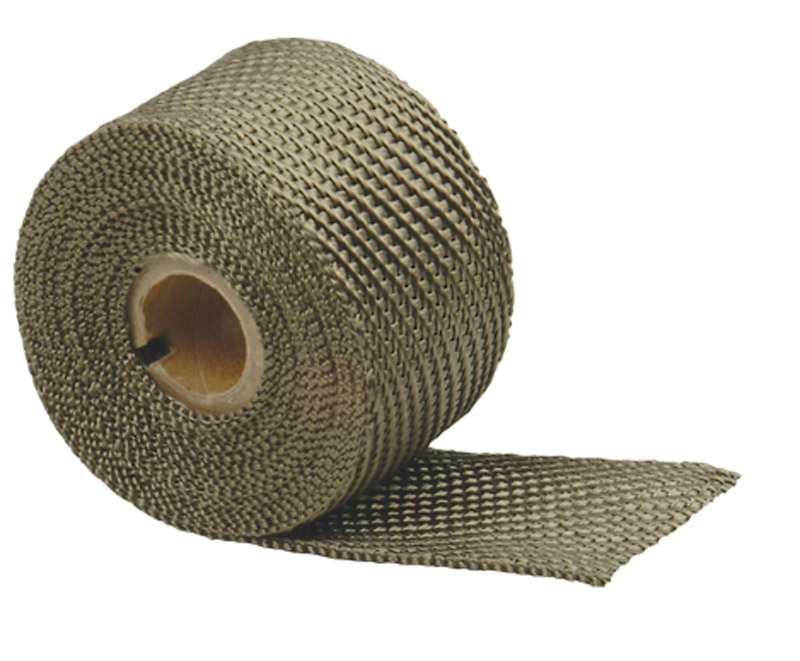 Conventional exhaust wrap products are made of woven glass fiber. To install glass fiber exhaust wraps, you wet the material such that its water soaked, then you wrap the exhaust pipe in question with 1/4-1/2-in overlap. Most exhaust wrap makers sell special stainless steel locking ties which are used to retain the wrap on the pipe. Once it dries, some makers of exhaust wrap suggest a spray-on silicon coating which seals the wrap and increases its longevity.
Conventional exhaust wrap products are made of woven glass fiber. To install glass fiber exhaust wraps, you wet the material such that its water soaked, then you wrap the exhaust pipe in question with 1/4-1/2-in overlap. Most exhaust wrap makers sell special stainless steel locking ties which are used to retain the wrap on the pipe. Once it dries, some makers of exhaust wrap suggest a spray-on silicon coating which seals the wrap and increases its longevity.
Exhaust wrap can be used on uncoated short- or long-tube header sets as well as on exhaust system parts under the car. Do not use exhaust wrap on header sets or exhaust pipes made of mild steel which have been metallic ceramic coated. The combination of metallic-ceramic coating the the exhaust wrap insulates so well that the mild steel gets too hot and disintegrates. With mild steel exhaust parts you have to choose: coating or wrapping. Typically, I coat headers and exhaust manifolds and wrap head pipes and exhaust pipes. It’s not recommended to wrap catalytic converters because of their need to radiate heat to prevent damage to the converter.
The latest exhaust wrap product to come to market is from heat insulation specialist Design Engineering, Inc. It’s called “Titanium” Exhaust Wrap. The product contains no significant amount of metallic titanium. The brand name “Titanium,” according to DEI spokesperson, Dan Stark, was picked because of the product’s high strength and light weight. What makes DEI’s Titanium Exhaust Wrap unique is that it is not made of glass fibers. It is made of fibrous lava rock, which is both lighter and even more tolerant of high temperature than glass. At first, I was a bit skeptical of lava rock fiber but, after talking more with Dan Stark, I’m a believer. In short, DEI has lava rock mined in large loads, crushed and melted at very high temperatures. It is then stranded and spooled. The fibers are then added to other fibers to make threads and, finally, it’s woven into DEIs special fabric which is then made into strips of exhaust wrap. Titanium Wrap is lighter. I did not have the ability to test its additional 600°F of temperature tolerance, but I’ll take DEI’s word that its temperature limit for direct heat is 1800°F, up from the glass fiber product’s 1200°F maximum.
The best characteristics of DEI’s Titanium exhaust wrap are: 1) you don’t have to wet it prior to installation. That makes the installation process far less messy, and 2) you don’t need to seal it with a high-temperature silicone spray to get best results. In fact DEI says not to use any sealer on Titanium Wrap. All you do is wrap the pipe, secure the wrap with DEI’s stainless locking ties then go drive the car. As with all exhaust wraps, during the first one or two heat cycles, the stuff smokes a bit but after that, you don’t know it’s there unless you look under the car.
I used two 25-foot rolls of 2-in. Titanium Exhaust Wrap (PN 100131) to wrap the exhaust system on a 2012 Z06. The main reason for doing this is my ongoing project to reduce heat radiation into the car’s interior. Much more so that my C5 Z06, the ’12 has a problem with heat radiation off the undercar parts of the exhaust and into the interior. Wrapping the pipes aft of the cats and wrapping the mid-section all the way back to the connection at the mufflers is the third part of my project. The first was installing an Elite Engineering Insulated Tunnel Closeout Plate I ordered from Zip Products and the second was installation of sections of DEI Floor and Tunnel Shield II in selected spots under the car. Both those products are reviewed elsewhere in the “Engine-Driveline” product evaluation section.
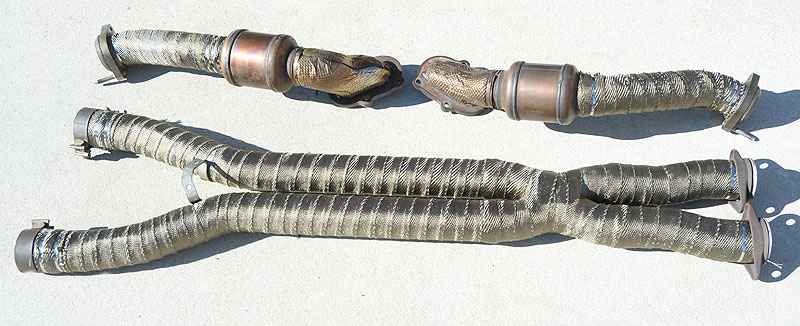 My Titanium Exhaust Wrap project was done during the winter, so the temperature reduction I perceived in the interior was modest but once the Spring and Summer arrive, my guess is the difference will be significant. Combine that with Titanium Exhaust Wrap’s ease of installation and you have an outstanding thermal insulation product.
My Titanium Exhaust Wrap project was done during the winter, so the temperature reduction I perceived in the interior was modest but once the Spring and Summer arrive, my guess is the difference will be significant. Combine that with Titanium Exhaust Wrap’s ease of installation and you have an outstanding thermal insulation product.
For more information, visit the DEI web site DEI products can be purchased from Summit Racing

